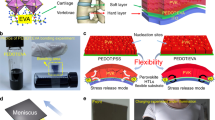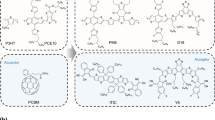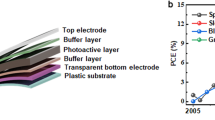Abstract
Large-area flexible organic photovoltaic modules suffer from electrical shunt and poor electrical contact between adjacent subcells, causing efficiency and stability losses. Here we improve the performance of large-area flexible organic photovoltaic modules through suppressing electrical shunt and improving electrical contact. We embed large-area silver nanowire electrodes into polymer substrates to reduce surface roughness and therefore to suppress electrical shunt. We deposit chromium and silver lines between adjacent subcells to improve electrical contact. We show that chromium suppresses the aggregation of the silver film, increasing its laser fluence tolerance and retaining its conductance under thermal annealing, mechanical bending and illumination. These improvements enhance the photovoltaic efficiency and illumination stability of the flexible organic photovoltaic modules. Large-area flexible modules achieve certified efficiencies of 14.04% (active area: 41 cm2) and 13.10% (active area: 370 cm2, with an open-circuit voltage of 103.51 V) and retain 90.4 ± 2.3% of the initial efficiency after continuous illumination for 912 hours.
This is a preview of subscription content, access via your institution
Access options
Access Nature and 54 other Nature Portfolio journals
Get Nature+, our best-value online-access subscription
$29.99 / 30 days
cancel any time
Subscribe to this journal
Receive 12 digital issues and online access to articles
$119.00 per year
only $9.92 per issue
Buy this article
- Purchase on Springer Link
- Instant access to full article PDF
Prices may be subject to local taxes which are calculated during checkout




Similar content being viewed by others
Data availability
The datasets analysed and generated during the current study are included in the paper and its Supplementary Information. Source data are provided with this paper.
References
Park, S. et al. Self-powered ultra-flexible electronics via nano-grating-patterned organic photovoltaics. Nature 561, 516–521 (2018).
Inganas, O. Organic photovoltaics over three decades. Adv. Mater. 30, e1800388 (2018).
Cui, Y. et al. Wide-gap non-fullerene acceptor enabling high-performance organic photovoltaic cells for indoor applications. Nat. Energy 4, 768–775 (2019).
Zhang, G. et al. Renewed prospects for organic photovoltaics. Chem. Rev. 122, 14180–14274 (2022).
Yoon, S. et al. High-performance scalable organic photovoltaics with high thickness tolerance from 1 cm2 to above 50 cm2. Joule 6, 2406–2422 (2022).
Jiang, Z. et al. Highly efficient organic photovoltaics with enhanced stability through the formation of doping-induced stable interfaces. Proc. Natl Acad. Sci. USA 117, 6391–6397 (2020).
Wang, Y. et al. Origins of the open-circuit voltage in ternary organic solar cells and design rules for minimized voltage losses. Nat. Energy 8, 978–988 (2023).
Jiang, Y. et al. An alcohol-dispersed conducting polymer complex for fully printable organic solar cells with improved stability. Nat. Energy 7, 352–359 (2022).
Dennler, G., Lungenschmied, C., Neugebauer, H., Sariciftci, N. S. & Labouret, A. Flexible, conjugated polymer-fullerene-based bulk-heterojunction solar cells: basics, encapsulation, and integration. J. Mater. Res. 20, 3224–3233 (2005).
Krebs, F. C., Fyenbo, J. & Jørgensen, M. Product integration of compact roll-to-roll processed polymer solar cell modules: methods and manufacture using flexographic printing, slot-die coating and rotary screen printing. J. Mater. Chem. 20, 8994–9001 (2010).
Hösel, M., Søndergaard, R. R., Jørgensen, M. & Krebs, F. C. Fast inline roll-to-roll printing for indium-tin-oxide-free polymer solar cells using automatic registration. Energy Technol. 1, 102–107 (2013).
Carlé, J. E. et al. Overcoming the scaling lag for polymer solar cells. Joule 1, 274–289 (2017).
Kubis, P. et al. High precision processing of flexible P3HT/PCBM modules with geometric fill factor over 95%. Org. Electron. 15, 2256–2263 (2014).
Lucera, L. et al. Highly efficient, large area, roll coated flexible and rigid OPV modules with geometric fill factors up to 98.5% processed with commercially available materials. Energy Environ. Sci. 9, 89–94 (2016).
Han, Y. et al. 12.42% monolithic 25.42 cm2 flexible organic solar cells enabled by an amorphous ITO-modified metal grid electrode. Adv. Mater. 34, e2110276 (2022).
Shen, Y. F. et al. In situ absorption characterization guided slot-die-coated high-performance large-area flexible organic solar cells and modules. Adv. Mater. 35, e2209030 (2023).
Kwon, H.-C. et al. Overcoming the low-surface-energy-Induced wettability problem of flexible and transparent electrodes for large-area organic photovoltaic modules over 500 cm2. Adv. Energy Mater. 12, 2200023 (2022).
Choi, S. et al. ITO-free large-area flexible organic solar cells with an embedded metal grid. Org. Electron. 17, 349–354 (2015).
Mao, L. et al. Flexible large-area organic tandem solar cells with high defect tolerance and device yield. J. Mater. Chem. A 5, 3186–3192 (2017).
Qin, F. et al. 54 cm2 large-area flexible organic solar modules with efficiency above 13%. Adv. Mater. 33, e2103017 (2021).
Xie, C., Liu, Y., Wei, W. & Zhou, Y. Large-area flexible organic solar cells with a robust silver nanowire-polymer composite as transparent top electrode. Adv. Funct. Mater. 33, 2210675 (2022).
Yu, J. S. et al. Silver front electrode grids for ITO-free all printed polymer solar cells with embedded and raised topographies, prepared by thermal imprint, flexographic and inkjet roll-to-roll processes. Nanoscale 4, 6032–6040 (2012).
Dong, X. et al. Flexible nonfullerene organic solar cells based on embedded silver nanowires with an efficiency up to 11.6%. J. Mater. Chem. A 7, 1989–1995 (2019).
Wang, Z. et al. Manipulating the macroscopic and microscopic morphology of large-area gravure-printed ZnO films for high-performance flexible organic solar cells. Energy Environ. Mater. 7, e12592 (2023).
Sun, L. et al. Flexible all-solution-processed organic solar cells with high-performance nonfullerene active layers. Adv. Mater. 32, e1907840 (2020).
Sun, Y. et al. Flexible organic photovoltaics based on water-processed silver nanowire electrodes. Nat. Electron. 2, 513–520 (2019).
Zeng, G. et al. Realizing 17.5% efficiency flexible organic solar cells via atomic-level chemical welding of silver nanowire electrodes. J. Am. Chem. Soc. 144, 8658–8668 (2022).
Azani, M. R., Hassanpour, A. & Torres, T. Benefits, problems, and solutions of silver nanowire transparent conductive electrodes in indium tin oxide (ITO)-free flexible solar cells. Adv. Energy Mater. 10, 2002536 (2020).
Heise, G. et al. Demonstration of the monolithic interconnection on CIS solar cells by picosecond laser structuring on 30 by 30 cm2 modules. Prog. Photovolt. Res. Appl. 23, 1291–1304 (2015).
Palma, A. L. et al. Laser-patterning engineering for perovskite solar modules with 95% aperture ratio. IEEE J. Photovolt. 7, 1674–1680 (2017).
Brooks, K. G. & Nazeeruddin, M. K. Laser processing methods for perovskite solar cells and modules. Adv. Energy Mater. 11, 2101149 (2021).
Tam, K. C., Kubis, P., Maisch, P., Brabec, C. J. & Egelhaaf, H. J. Fully printed organic solar modules with bottom and top silver nanowire electrodes. Prog. Photovolt. Res. Appl. 30, 528–542 (2021).
Qin, F. et al. Robust metal ion-chelated polymer interfacial layer for ultraflexible non-fullerene organic solar cells. Nat. Commun. 11, 4508 (2020).
Cui, Y. et al. Single-junction organic photovoltaic cells with approaching 18% efficiency. Adv. Mater. 32, e1908205 (2020).
Sangiorgi, R., Muolo, M. L. & Passerone, A. J. A. M. Surface tension and adsorption in liquid silver-oxygen alloys. Acta Metall. 30, 1597–1604 (1982).
Xie, X. et al. Thermal conductivity, heat capacity, and elastic constants of water-soluble polymers and polymer blends. Macromolecules 49, 972–978 (2016).
Choi, J. H., Ryu, K., Park, K. & Moon, S.-J. Thermal conductivity estimation of inkjet-printed silver nanoparticle ink during continuous wave laser sintering. Int. J. Heat. Mass Transf. 85, 904–909 (2015).
Acknowledgements
The work was supported by the National Natural Science Foundation of China (grant numbers 52273180, 51973074) and the special innovation funds of Wuhan National Laboratory for Optoelectronics. We also thank the Analytical and Testing Center of Huazhong University of Science and Technology for providing the facilities to conduct characterizations. We acknowledge J. Hu, D. Xue and S. Wang at Institute of Chemistry, Chinese Academy of Sciences for providing facilities and help on the measurement of LBIC mapping.
Author information
Authors and Affiliations
Contributions
X.L. and Y.Z. conceived the idea. X.L and Y.L. fabricated the flexible large-area organic solar cells modules. X.L. and C.X. tested the large-area modules and performed the stability measurement of the large-area modules. X.L., H.Z. and K.F. performed the fabrication, measurement and optimization of flexible small-area solar cells. X.L. and Z.X. tested the laser ablation threshold of the films. X.L. and W.W. measured EQE. X.L. wrote the first draft of the paper. Y.Z. supervised the research and revised the paper. All the authors revised and approved the paper.
Corresponding author
Ethics declarations
Competing interests
The authors declare no competing interests.
Peer review
Peer review information
Nature Energy thanks Weiwei Li, Chang-Zhi Li, Hae Jung Son and the other, anonymous, reviewer(s) for their contribution to the peer review of this work.
Additional information
Publisher’s note Springer Nature remains neutral with regard to jurisdictional claims in published maps and institutional affiliations.
Supplementary information
Supplementary Information
Supplementary Figs. 1–28 and Tables 1 and 2.
Supplementary Data 1
Data for Supplementary Fig. 10.
Supplementary Data 2
Data for Supplementary Fig. 13a.
Supplementary Data 3
Data for Supplementary Fig. 14.
Supplementary Data 4
Data for Supplementary Fig. 18b.
Supplementary Data 5
Data for Supplementary Fig. 19.
Supplementary Data 6
Data for Supplementary Fig. 20.
Supplementary Data 7
Data for Supplementary Fig. 27.
Supplementary Data 8
Data for Supplementary Table 1.
Supplementary Data 9
Data for Supplementary Table 2.
Source data
Source Data Fig. 1
Current–voltage data, histograms of efficiencies.
Source Data Fig. 2
Histograms of efficiencies.
Source Data Fig. 3
Statistical source data, histograms of laser fluence.
Source Data Fig. 4
Statistical source data.
Rights and permissions
Springer Nature or its licensor (e.g. a society or other partner) holds exclusive rights to this article under a publishing agreement with the author(s) or other rightsholder(s); author self-archiving of the accepted manuscript version of this article is solely governed by the terms of such publishing agreement and applicable law.
About this article
Cite this article
Lu, X., Xie, C., Liu, Y. et al. Increase in the efficiency and stability of large-area flexible organic photovoltaic modules via improved electrical contact. Nat Energy (2024). https://doi.org/10.1038/s41560-024-01501-1
Received:
Accepted:
Published:
DOI: https://doi.org/10.1038/s41560-024-01501-1



